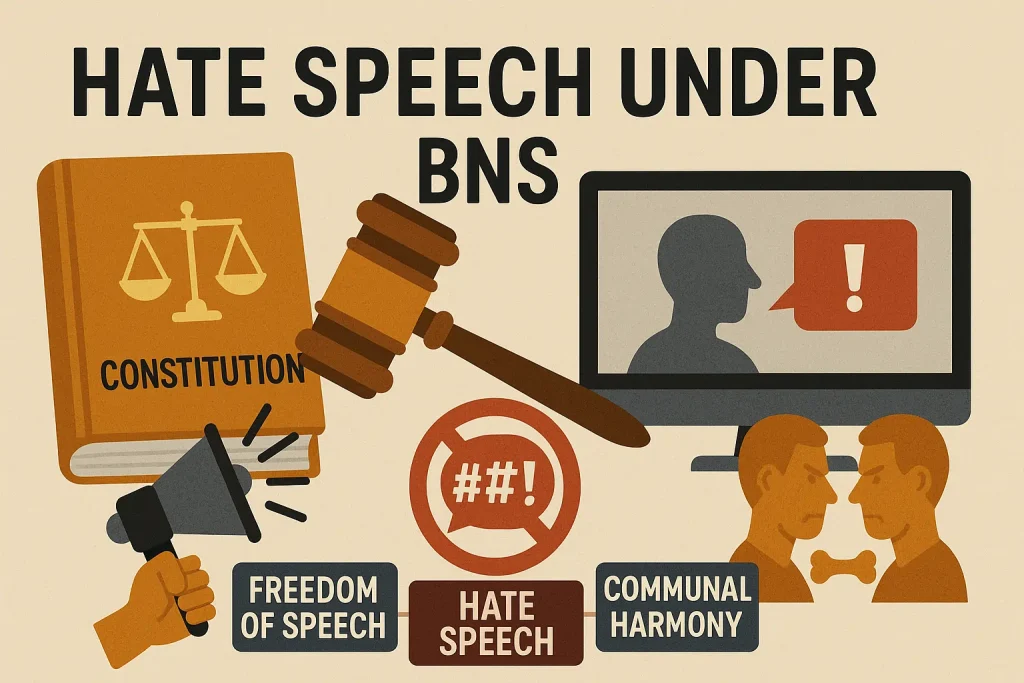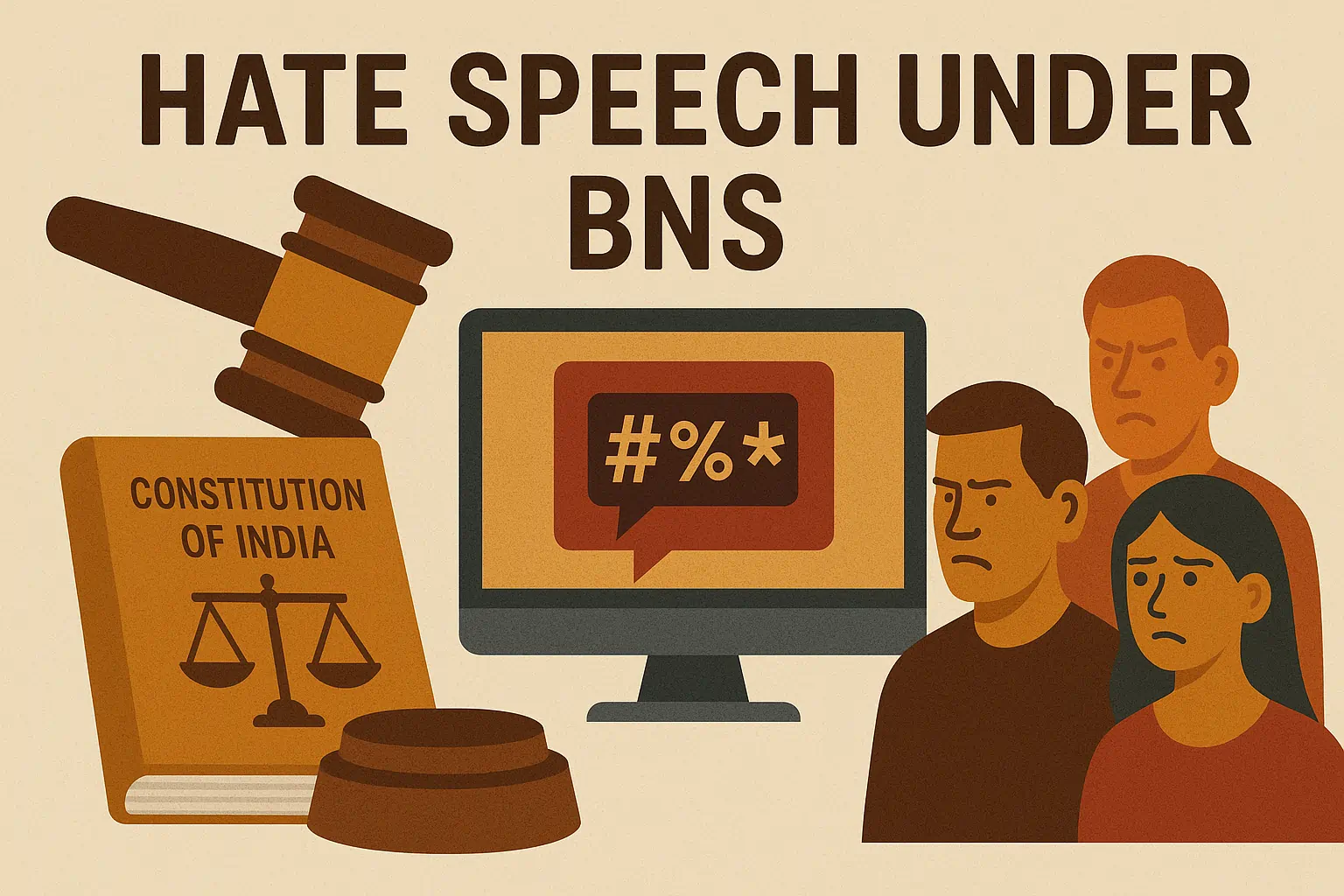
When, in 2023, BNS was enacted, replacing the colonial law, i.e., Indian Penal Code (IPC), it was considered as modernization of criminal law. It was a promising act to move towards more clarity and reform, but its treatment of hate speech is giving rise to more questions than solutions.
India has long struggled to strike a balance between the freedom of expression, as described under Article 19(a) of the Indian Constitution, and the imposition of reasonable restrictions, as prescribed under Article 19(2) of the Indian Constitution. These laws especially gain significance in the context of communal harmony, public morality, and hate speech. BNS retains and has just renumbered the key hate speech-related provision of the IPC. The main question that remains is whether it has brought about any meaningful legal change or constitutional equality.
The Provisions: Same Wine, New Bottles?
The BNS has re-enacted three main key hate speech provisions just under new section numbers:
Section 196 of BNS replaces section 153A, which aims to criminalise any speech or action that promotes “disharmony or feelings of enmity, hatred or ill-will” between groups belonging to different religions, castes, linguistic or regional groups.
Section 299, which punishes “deliberate and malicious acts” aimed at outraging the religious feelings by insulting them. This section carries forward the main essence of IPC section 295A.
Section 353(2) replaces Section 505(2), which aims at criminalizing statements, reports, or rumors that incite enmity between classes and disturb public tranquility.
The new development brought by BNS into this is the inclusion of speech disseminated through means of electronic communication. Still, the approach and language of this section remain the same. There are several words, such as “disharmony,” “ill-will,” and “outrageous feelings,” which are ambiguous.
Constitutional Concerns Persist
The Indian Constitution has imposed some reasonable restrictions on a person’s freedom of speech. The restrictions are aimed at maintaining public order, morality, decency, etc. Time and again, the Supreme Court has held that such restrictions must be proportionate and narrowly tailored. In the landmark judgement of Shreya Singhal v. Union of India (2015), the court struck down the infamous Section 66A of the IT Act as it was considered to be “vague and overbroad.”
Similarly, Sections 196, 299, and 353 of the Bhartiya Naya Sanhita Act seem to be in the light of the same criticism. What exactly qualifies as disharmony? At what level does the criticism of a particular religion become an “insult” to it? Are some of the important questions that the law doesn’t answer? This ambiguity hands enormous discretionary power to the police and executive authorities.
It is worthwhile noting that these sections have been invoked against journalists, artists, and prominent opposition figures routinely. Often, these statements are just uncomfortable and fall short of inciting violence.
The Misuse Factor: More Cases, Fewer Convictions
Based on data given by the National Crime Records Bureau, several cases filed under the old Se in Section 153A of the IPC have skyrocketed in the last few years. They have increased from 478 in 2016 to 1804 in 2020. Despite this, the conviction rates remain very low, throwing light on the misuse or overuse of the law.
BNS, although the freshly enacted law holds the same paint similar to old laws. It is already showing signs of use in the same way.
In the recent case of 2025, the former MP of Kerala, P.C. George, was charged under Sections 196 and 299 for referring to Muslims as “terrorists” at a public gathering. Based on the previous offences, the High Court denied him bail. Even though these statements were problematic, the case stated that current penalties might be too weak to deter repeat offenders, despite the law continuing to be used selectively.
In contrast with this, the case of Karnataka BJP MLA Harish Ponzi, who faced the charges under section 353(2) for some remarks at a Temple rally. The high court raised the question to assess whether any actual harm was caused and granted bail. This inconsistency in how hate speech cases are governed highlights the lack of clear legal standards and established principles.
The Social Media Amplifier
Social media has become a powerful amplifier of hate speech. It is astonishing to see how quickly hate speech might spread online, allowing the inflammatory videos and messages to go viral within hours. In an investigation conducted in year to 2024, it was found that over 995 hate speech videos had been circulated through online mediums within a year. It was also found in this investigation that these acts were mostly done by the repeated offenders.
This raises another important question of governing social media hate speech. Even though BNS has included new sections to govern the electronic mediums, the law enforcement Agency still struggles to keep pace with it. Platforms delay the process of taking down the content, which gives the offenders time to escape the serious offences. In addition to this, even the codes are unable to work quickly, and since the video is already viral, the damage has already been done.
What the BNS Could Have Done — But Didn’t
Redefining the Indian criminal laws and especially the transition of IPC to BNS is not a very important opportunity. It was not a crucial step that could define the hate speech to make it constitutionally sound, Specific, and proportionate. But all it did was to just rearrange the old IPC framework.
There was no attempt made to define hate speech comprehensively. No clear parameters to define the harm. Note tools to offer distinction between opinion offence and incitement. In 2017, the Law Commission of India had utterly suggested that hate speech should be defined That insights discrimination, hostility, or violence. Even after this clear way forward, no steps were adopted
In addition to this, several provisions, such as 196, 197, 299, and 353, and overlapping in nature. This leads to confusion among the people and the creation of a duplicative web. A single act or speech can attract multiple FIRs, which results in legal harassment and procedural overreach.
The Way Forward
What India requires is fast action to make any meaningful changes. It needs more coherent, narrow, and principled speech law. One that distinguishes between genuine threats to public order and mere offence. Here are some specific recommendations.
The first thing required is a specific statutory definition of Hate Speech, which is based on incitement to discrimination or violence. Secondly most important thing is maintaining a higher threshold for prosecution, like clear intent, likelihood of harm, and imminent danger.
Imposing penalties for frivolous complaints is also very important. In addition to this, senior-level approval for registering FIRs under these provisions is also required. Lastly, comes development of fast fast-track mechanism for removing questionable content from digital platforms is required. While doing all of this, it is necessary to safeguard the freedom of speech.
Conclusion
The right to free speech and communal harmony are not mutually exclusive concepts. It becomes necessary to maintain a balance between them. This requires clear, fair, and constitutionally consistent laws. The BNS, unfortunately, still carries forward the vague nature of hate speech laws. If India is serious about safeguarding both dignity and democracy, legal reform must go beyond renumbering.
